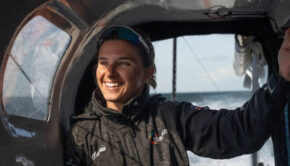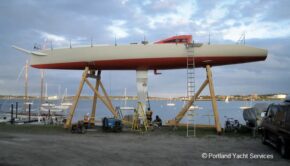Making the turn at Cape Horn
Published on January 29th, 2024
by Marco Nannini, Global Solo Challenge
(January 29, 2024) – In the dynamic and challenging realm of solo sailing, few feats are as awe-inspiring as navigating the treacherous waters of Cape Horn. In its first edition, the 2023-24 Global Solo Challenge has been graced with an extraordinary display of sailing prowess by Cole Brauer (USA).
Her journey around the legendary cape has been an excellent display of strategy, skill, and resilience.
On her rounding of Cape Horn on January 26, she was congratulated by sailing legends such as Sir Robin Knox-Johnston, president of the International Association of Cape Horners, and Dee Caffari, the first woman to sail solo nonstop around the world in both directions (eastward and westward).
The Global Solo Challenge, with a pursuit format and staggered starts saw 16 skippers taking the start, Brauer currently holds second place in the event having outpaced many of her fellow competitors.
She is still hard on the chase of the front running boat Mowgli, an Actual 36 sailed by French skipper Philippe Delamare currently leading the competition. Delamare rounded Cape Horn on January 9 in heavy weather conditions just ahead of a cold front that was threatening to bring messy and dangerous seas.
His experience and prior navigation in these areas meant he knew what to expect and his strong aluminum cruiser-racer gave him an edge in the heavy conditions of the screaming fifties where he was able to stay on course and sail the shortest distance of all competitors on his route to Cape Horn. Lighter weight racing boats, like Brauer’s Class40, often had to negotiate a path and find the balance between speed and risk mitigation.
Today, in fact, Francois Gouin on a similar Class40, Kawan3 Unicancer, reminded us of the perils of navigating in heavy seas in the remoteness of the South Pacific. The French skipper’s boat was knocked down by a breaking wave in the proximity of Point Nemo.
The boat’s spinnaker pole became dislodged and broke off two stanchions and a side window. With the hull laid on the side, mast in the water, the boat flooded with a foot of water before coming back upright.
Luckily, despite the inevitable scare, the mess inside the boat, the water to be pumped out, He was not injured and the water did not damage any of his electronics and especially the most crucial of aids to a solo sailor, the autopilot. He is back on route to Cape Horn, around 1600 miles ahead of him.
Brauer’s approach to the legendary cape began with meticulous weather monitoring. Understanding that weather models are only reliable for a short term, Brauer and her shore team analyzed the changing patterns with precision, preparing for the unpredictable. The reality of sailing is that while weather models give an indication of potential developments, the actual behavior of a system can vary significantly.
As she found herself between two low-pressure systems, weaving a delicate route away from the strongest winds and seas was paramount. The system trailing her was heading east, then was predicted to shift southward, squeezed by the Andean Mountain range.
This positioning presented a challenging scenario, with an area north and east of Brauer expected to be swept by very strong winds. However, by timing her movement southeast towards Cape Horn meticulously, she managed to stay out of the worst conditions, navigating through the path of least resistance on her route east.
Her prudent and cautious approach kept her boat, First Light, in good shape to face the last blow of the South Pacific before turning the corner into the South Atlantic. Reaching her “Everest of the seas” was far from easy and the emotions surrounding Cole’s rounding of Cape Horn were palpable.
Sharing her experience live on Instagram, she conveyed tears, joy, and relief as she reached east under fractional code zero and a reefed mainsail. Too far to see the Cape, she chose an offshore route to avoid the risks associated with heavy seas in shallower waters.
Her achievement at Cape Horn is a significant milestone in her sailing career. As a 29-year-old aiming to become the first American woman to sail solo nonstop around the world by the three great capes, her performance in the Global Solo Challenge 2023-24 has been remarkable.
More so, we strongly believe that on completion of the event, she will have managed to open many doors for her future self, having fully demonstrated she has what it takes to be a professional offshore solo sailor. A profession that requires a vast mix of skills including her down to earth positive communication skills which earned her a huge following on Instagram and other platforms.
Of the original 16 starters, three competitors have retired:
• Juan Merediz and Dafydd Hughes as a result of autopilot issues
• Ari Kansakoski following his dismasting north of the Crozet Islands
Delamare and Brauer are back in the South Atlantic after rounding Cape of Good Hope, Cape Leeuwin, and Cape Horn whilst the rest of the fleet is split between the Pacific and Indian oceans.
Next to negotiate his approach to Cape Horn is American skipper Ronnie Simpson sailing a 1994 vintage Open 50 which was donated by the previous owner, Whitall Stokes, to Patriot Sailing USA which Ronnie proudly represents as a US war veteran, injured in combat many years ago.
Sailing gave new goals and ambitions after recovery and his return to civilian life, which many veterans know can be a hard and difficult transition, to the point that Simpson even says that sailing somewhat saved his life.
His campaign was put together with very little time to spare and only thanks to the late onboarding of title sponsor Shipyard Brewing which was the deal breaker to even be able to make the start. With a tight schedule and lots of maintenance, upgrades, and work to be done to the boat, Simpson often felt the frustration of not having been able to set off as well prepared as he would have liked to be.
He capably dealt with many issues as they arose at sea but was forced to stop in Hobart for repairs to his sails and primary autopilot which makes his current third place even more remarkable. A stop in the Global Solo Challenge is permitted but receives a 4-day time penalty, which he observed in Tasmania before restarting.
Simpson’s approach towards Cape Horn has also been influenced by several heavy storms blocking his route which forced the American skipper to throttle back and slow down the boat to ensure he remained within manageable winds and waves whilst he let the worst of the low pressure systems blow east.
With under 750 miles to the dreaded cape, his eyes are firmly on the big prize and he has also chosen to time his rounding on the back of a heavy blow due to hit the archipelago de Hornos in the early hours of January 31.
Race details – Entry list – Start times – Tracking
Attrition List:
DNS: Peter Bourke – Class40, Imagine
DNS: Ivan Dimov – Endur37, Blue Ibis
DNS: Curt Morlock – IMOCA, 6 Lazy K
DNS: Volkan Kaan Yemlihaoğlu – Open 70, Black Betty
RTD: Juan Merediz – Class40, Sorolla
RTD: Dafydd Hughes – S&S 34, Bendigedig
RTD: Ari Känsäkoski – Class40, ZEROchallenge
The inaugural Global Solo Challenge 2023-24 seeks to be a budget-friendly solo, non-stop race around the world. Using a pursuit format for the 2023-24 race, 20 entrants from 34 to 70 feet have start times between August 26 to January 6 from A Coruña, Spain, with the first boat to return deemed the winner.
Source: GSC









 We’ll keep your information safe.
We’ll keep your information safe.